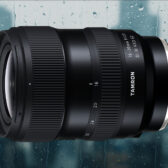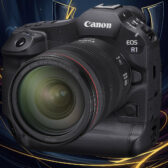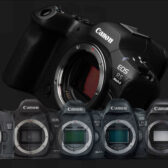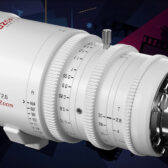m4/3 Competitor
Received some information about a possible Canon competitor to the Olympus/Panasonic micro 4/3 cameras.

Canon is researching such a camera design. There is a lot of close attention being paid to the success or failure of the system. Canon has no immediate plans to introduce such a camera to the marketplace, nor do they have any plans to become part of the micro 4/3 mount.
Canon’s interest seems to lie in making a CMOS based APS-C compact camera with a zoom. Not a new system. Leica and Sigma both have APS-C compact cameras now, albeit with a prime lens. Also, Nikon is rumored to perhaps have the same thing coming down their pipeline.
Another issue with a Micro Canon is the need for a 3rd lens format. EF-S and EF lenses would generally be too big on an EP1 sized camera. Do you think Canon really wants to get into that? If they did want a new lens format, medium format would be a far more desirable market.
All is not lost in the quest for a small camera body. You can expect a smaller Rebel down the line with an electronic viewfinder. It won’t be as small as the EP1 or GF1, but taking out the mirror box will shrink the size.
No new news on the often spoken about “G”MOS camera.
cr
|
When you purchase through links on our site, we may earn an affiliate commission. Here's how it works. |









Yes, yes, yes! I’ve been searching and searching for a small-sensor camera to no avail! Imagine if they could make 4/3 or even 1/1.7″ that would be great. I need more noise in my pictures. WTF.
I love this rumor. A small mirrorless rebel to combine with a 35 2.0 or a 50 1.8 or other small lenses just to accomplish a bigger camera is a very lovely idea. If the price is nice (let’s say 250 euro without lens) I’ll buy one.
Too great a risk for Canon if a new mount is involved IMHO. A G11 body is nearly the same size of a Rebel.
Isn’t this just a glorified version of a SX1? I would pay $600 for a decent viewfinder and a 1.6 crop with good fixed zoom lens.
Hmm a rebel without the mirrorbox but still the ability to use EF and EFs lenses. I like that! Great Vacation camera.
If they did a micro and just came out with one ~30mm pancake lens that would be great. I don’t really care much how big the body is, I really just want an APS-C or larger sensor that will flash sync at 1/1000 and use my Canon lenses.
I think a G11 type camera with compact body and fixed zoom would be a good idea, as long as it included viewfinder and flash.
I know its possible, just look at all those 35mm film cameras with compact bodies and fixed zooms. I’ve no need for a lcd at all.
Why is medium format a far more desirable market? If this was where the money is, everyone would have a medium format offering.
Exactly.
There is way, way more money in making a compact camera.
Canon would be lucky to break even with a medium format system.
I’m loving the idea of a really small Rebel with 1.6x crop, standard Canon lens mount and a wide, flat prime lens.
The Camera I want is like the Leica X1 but with Canon sensor and processor. I like the Ep-1 and GF1 but I don’t want to buy a new system. I want a compact camera with a big sensor and Canon guts.
I like what Mike V says. I’d be ecstatic with a fast EF-S 26-30mm pancake on the front of my Rebel. It’d still be bigger than an m4/3 rig, but small enough to be reasonably portable.
Canon has had crop bodies/sensors since as far back as the ill-fated APS Film EOS-IX and they ~still~ don’t have a fast normal EF-S prime lens.
Of course, a fast normal pancake would also make a nice launch lens for a mirror-free Canon crop camera.
A few reasons probably.
1) High margin and low yield.
2) Prestige in marketing the brand
3) Sorta like race cars, expensive new technology could be tested out and evolved before it reaches the masses.
I think that a biggish compact could use EF-mount, if a camera like that was released with a APS-C sized sensor it would be #1 on my to-buy list.
There are quite a few small and light EF lenses including of course the nifty-nifty, geez, I would probably just stick that lens on the camera and just weld it together.
Which brings me to my usual rant about the need of at least two more cheap EF lenses like the 50mm wonder, just make them wide-ish, plasticy and sharp. Sell them together with that new micro-Rebel (just for goodness sake don’t call it a Rebel!) and you will make a lot of money Canon.
That would be awesome for weddings – stealth shooting with a 50 1.4 Mark II :)
A souped up G11 with:
(1) the shutter lag of a 7D
(2) a 2.8f lens
(3) 24mm – 200mm
And I would be happy
How do you get the shutter lag of a 7D/50D without a proper mirror box/viewfinder? It’s the “live view” P&S paradigm that creates the problem in the first place.
“(2) a 2.8f lens
(3) 24mm – 200mm”
Yeah, and medium format sensor, price under $100. Honestly, do you have any idea what you are asking for? Even for a P&S with a tiny sensor this lens would be HUGE and the glass expensive if even feasible to design.
That’s one of the stupidest comments I’ve seen in a long time. Desireable for any company (maybe except for Leica) means high volume which is much more profitable than selling a few thousand medium format cameras each year. Medium format would also mean a completely new series of lenses while a Micro EF could work with a couple of new ones and standard FF and EFS lenses like Olympus and Panasonic do.
“Canon’s interest seems to lie in making a CMOS based APS-C compact camera with a zoom. Not a new system”
“All is not lost in the quest for a small camera body. You can expect a smaller Rebel down the line with an electronic viewfinder. It won’t be as small as the EP1 or GF1, but taking out the mirror box will shrink the size”
——————————————
This is a contradiction in terms.
Removing the mirror from a Canon Rebel to make it smaller would be effectively creating a new system. If you want to make the camera smaller not only do you have to remove the mirror but you also need to reduce the flange focal depth. Otherwise, removing the mirror would only leave an unused empty space inside the camera.
And if, indeed, you reduce the flange focal depth reducing the size of the camera, all Canon lenses would become unusable, and you would have to design new lenses adapted to the shorter flange focal length, thus, creating a new system.
This rumor has zero credibility
What I want is an EF-S 22mm 1.4 (36 mm equiv), EF-S 30mm 1.4 (48mm equiv) and a EF 50mm 1.4 Mk II (80mm equiv) or a 55mm 1.4 (88mm equiv). All with I/R, CA etc like an EF-S 17-55mm 2.8. To keep size down a 1.8/2.0 22mm and 30mm would be OK. I’d pay $500.00/$600.00 for any of these.
BIG, HEAVY lenses SUCK. Big, heavy cameras also SUCK.
You’re wrong, just because the mirror is removed doesn’t mean they cant change the design/size of a DSLR and make sure current lenses continue to work.
No prism immediately takes bulge off the top. Who says the viewfinder has to be centered on the camera? You could put an EVF in the same sort of place like a rangefinder.
Can’t stand people that think they know everything.
“Removing the mirror from a Canon Rebel to make it smaller would be effectively creating a new system. If you want to make the camera smaller not only do you have to remove the mirror but you also need to reduce the flange focal depth. Otherwise, removing the mirror would only leave an unused empty space inside the camera.”
That is not strictly correct, just removing the pentaprism, the mirror and the associated systems will make the camera smaller. You get a lot of space that can be used to electronic components since the back of the camera would be presumably occupied by a large screen.
“And if, indeed, you reduce the flange focal depth reducing the size of the camera, all Canon lenses would become unusable, and you would have to design new lenses adapted to the shorter flange focal length, thus, creating a new system.”
Again, not quiet true. If you decided to make the camera MUCH smaller by making a thinner body and changing the focal length you can still use the old lenses with very simple adapters.
I take it that, in the first sentence, you meant that “just because the flange focal depth remains the same doen’t mean they can’t change the design and size of the camera”
Well, the empty space I was talking about is that of the movable part of the mirror system, i.e. the piece between the lens and the sensor. So if you don’t reduce the flange focal depth to take advantage of that space, the resulting camera will be exactly as thick as it was with the mirror. And then, the lenses will be the same ones, therefore making the overal depth of the system exactly the same.
Now, I take it that, in your second sentence, you meant that it is the pentaprism on top of the camera that you can indeed remove making the camera smaller, at least height-wise. I take your point, one of the factors that make both the Oly EP-1 and the Panasonic GF1 smaller than the G1 and reflex cameras is their absence of a viewfinder.
However, in my view, it is the depth of the camera the number one factor that can make the overall system significantly smaller, both the depth of the camera itself and the depth of the lenses.
Actually, I’d much rather buy a panasonic G1 in combination with the 20mm pancake, than the GF1 or the EP-1. I just need the viewfinder. When pana or oly (or even Fuji, as rumors say they are joining the M4/3 platform) release a sort of GF1 with a good integrated viewfinder, I’ll be willing to pay a good sum of money to get it.
By the way, if it wasn’t my intention to come off as a know-it-all. I just thought I for once knew a bit about this one, and I think this rumor is really far-fetched.
Peace
I take your points, but
1) removing the mirror and the associated systems (leaving the flange focal depth the same) could reduce camera size hight and width wise, but not really depth wise. And I think it is mainly the depth of the camera and the lenses that make our dslr systems so bulky.
2) If they indeed reduce the flange focal depth, very simple adapters could, sure enough, make the old lenses work (micro 4/3 lenses are of course using these adapters), but the adapter would do nothing but adding the missing focal depth, so, again, the overall depth of the system would remain the same. But it they went through the fuss of reducing the flange focal depth it would certainly be because they would design new lenses, and that, again, would be designing a new system.
Else, what would be the point of reducing the focal depth only to have to increase it again with the adapters?
So while I give you guys you could reduce the size of the camera in every dimension and corner except for the depth, I don’t really see the point. I bet you guys, when Canon, Nikon, Sony, and every player in the market begins making (and they will) mirrorless cameras, they will all have the flange distance reduced, and they will all be released with new lenses. They will all be new systems with backwards compatibility via the aforementioned adapters.
Or so I think, anyway
Have a nice day
I don’t understand the appeal of these cameras. I have absolutely no problem toting around my backpack, with as much stuff crammed into it as possible.
If you stress size over quality, get a point-n-shoot.
If you stress quality over size, get a DSLR and do it right.
When you compromise, no one wins….
I find this whole concept of a pocket sized camera with DSLR-like image quality very appealing. There are times when I don’t want to drag my big DSLR around with me and something to stick in my pocket would be ideal.
However, at this point in the game I have no desire to purchase one. I think they’re too new and the drawbacks vs. cost just plain aren’t worth it to me. In a year or two when there’s more options out there, then I’ll consider it.
I’d like to see a model with no a LCD and a viewfinder, if that’s make it super-compact.
Canon using the 4/3 system would be nice, but I don’t see that happening.
“Canon’s interest seems to lie in making a CMOS based APS-C compact camera with a zoom”
this seems to make sense and canon will probably call this the Powershot Pro2 or Pro-whatever (more likely than a G-whatever). and while Leica and sigma chose primes for their fixed lens APS-C cameras, Canon won’t be the first to opt for a zoom, the very first non-SLR non-RF digital camera was… the Sony R1 which had a very nice 24-120 zoom, that cam was not compact at all, maybe canon will be the first to have a compact large sensor camera with a fixed-zoom lens (you have to say too many things in order to be able to say “canon is the first” rightfully here). as usual the camera will get some glowing reviews and publicity although it will be somehow crippled as usual with canon, announcement will be on a moonless gloomy day next autumn
Many people have alos become fans of Paul Smith Shoes since they came into the market. I also one of them , I very like Paul Smith Wallets and <a Paul Smith Belts,It designs very good.
I’m sure that Canon is watching EP-1, EP-2, and GF-1 sales closely and has a small team working on a design in case it needs to react to this market quickly. However, I sincerely doubt any “go” decision has been made, especially as the bigger threat actually seems to be coming from Sony’s entry-level DSLRs.
DSLR sales are up, and as a result it is Sony much more than Panasonic or Olympus that is gaining share.
In terms of size segmentation, while men have three sizes in mind (“pants-pocketable”, “jacket-pocketable”, and “not-pocketable”), women also consider “pursable”.
The “pursable” segment is what the 1000D and 500D with the EF-S kit lens are aimed squarely at. I don’t think the size benefit of going to a mirrorless APS-C setup is worth what you get in this case for most women.
Fundamentally, you can’t get enough performance in man-pocketable optics to outperform a G11 – which trades photo quality for flexibility at the same size when compared to a MFT camera. (Smaller sensor allows smaller zoom lens.)